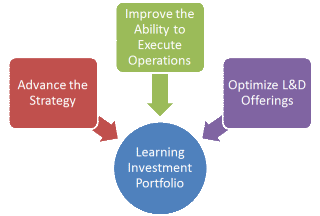How to Facilitate an Annual Planning Workshop (Company-Wide)
The annual planning workshop produces a bottom-up reset to the Learning Investment Portfolio.
Overview
Our guideline is "L&D facilitates but the business decides."

Under a centralized funding model, a company must create some mechanism to select which investments to make in learning. We suggest that this is done in levels. First, each business group makes its recommendation by generating a prioritized set of options for itself. Then a learning council (composed of senior business leaders) considers the combined set of group requests and makes the overall decision.
Since a company may make dozens or hundreds of distinct investments, the learning council requires help in framing the decision in a pragmatic way. The L&D leader ensures this legwork is done and facilitates the workshop.
Place in the Governance Process
Once a year, L&D and the business conduct a deep dive to reset the Learning Investment Portfolio. This process typically takes most of the late third quarter and early fourth quarter. There are three steps:
- Each business group defines a group-level Learning Investment Proposal.
- The learning leader constructs a consolidated Learning Investment Proposal.
- The learning leader conducts an Annual Planning Workshop in which the learning council resets the Learning Investment Portfolio.
Workshop Goals
The goals are to establish:
- What level of investment in L&D is appropriate to make this year?
- Are we allocating the investment appropriately between strategic and operational needs and current (one to two years) versus future (three to five years) needs?
- Are we allocating spending appropriately between business units?
The approach makes it clear to the business leaders what they get at each level of investment and that the decision lies in their hands. The approach avoids the problems of arbitrary decisions (e.g., “You get 5 percent more than last year”) or inappropriate responsibilities (e.g., “We’ve given you the money. It’s your job to make good use of it.”).
While the basic decision is to choose between investment levels, the council need not restrict itself to that. It may choose different levels for different business groups. For example, the council might decide that “Given that new product development is so critical for us right now, we will fund R&D at the ‘full’ level even though we are funding other groups only at the 85 percent level.” The council might even get into line-item detail. For example, one business leader might say, “I agree overall with setting funding this year at the 85 percent level. But I request that we also fund one item that does not make it on that list for these reasons. Can we agree to elevate that one item?”
Deliverables
- An approved companywide Learning Investment Portfolio. This specifies the budget level and, possibly, some fine-tuning of which specific needs will be supported.
- Ownership of the investment portfolio by senior business leaders. They “get it” and see how the L&D function is taking pains to use the organization’s resources wisely.
- More effective usage of learning as a tool to drive the business. When the learning council considers spending across business groups, business leaders may challenge each other on how they are using the organization’s resources. These debates happen enable business leaders to learn from each other as they think through their decisions and explain their rationales. As these debates happen year after year, they gradually enable business leaders to build expertise in using L&D as a strategic investment.
